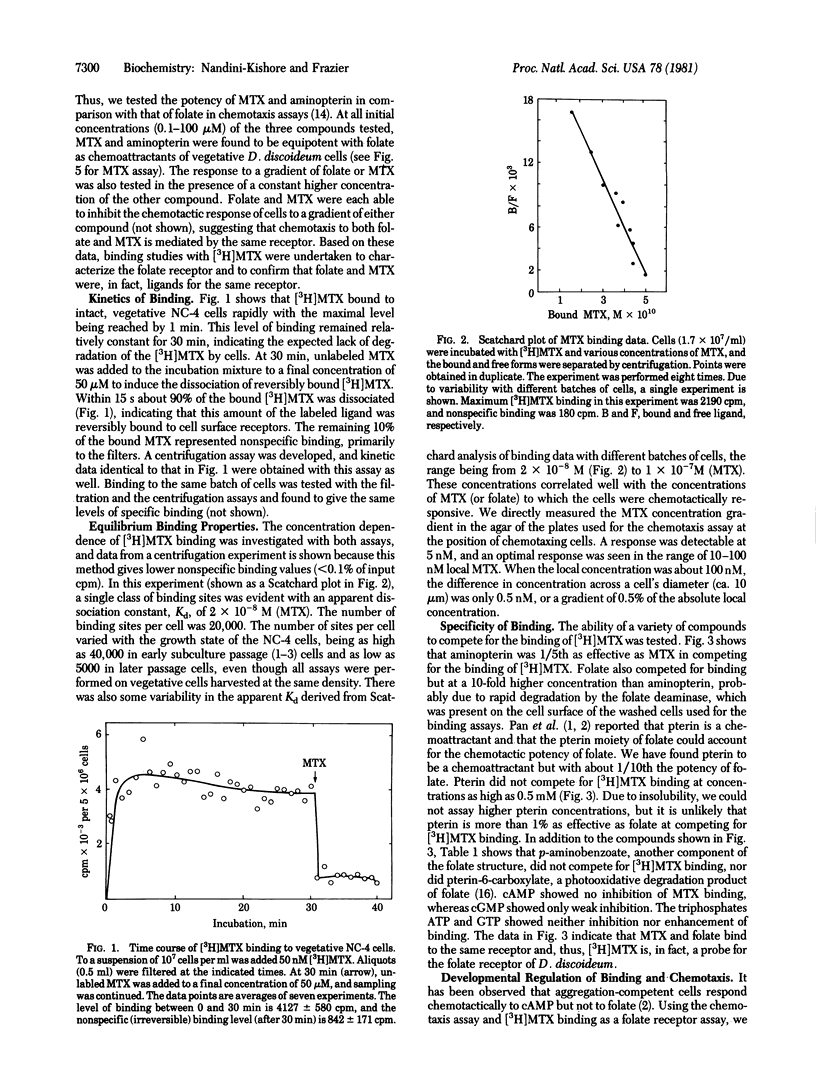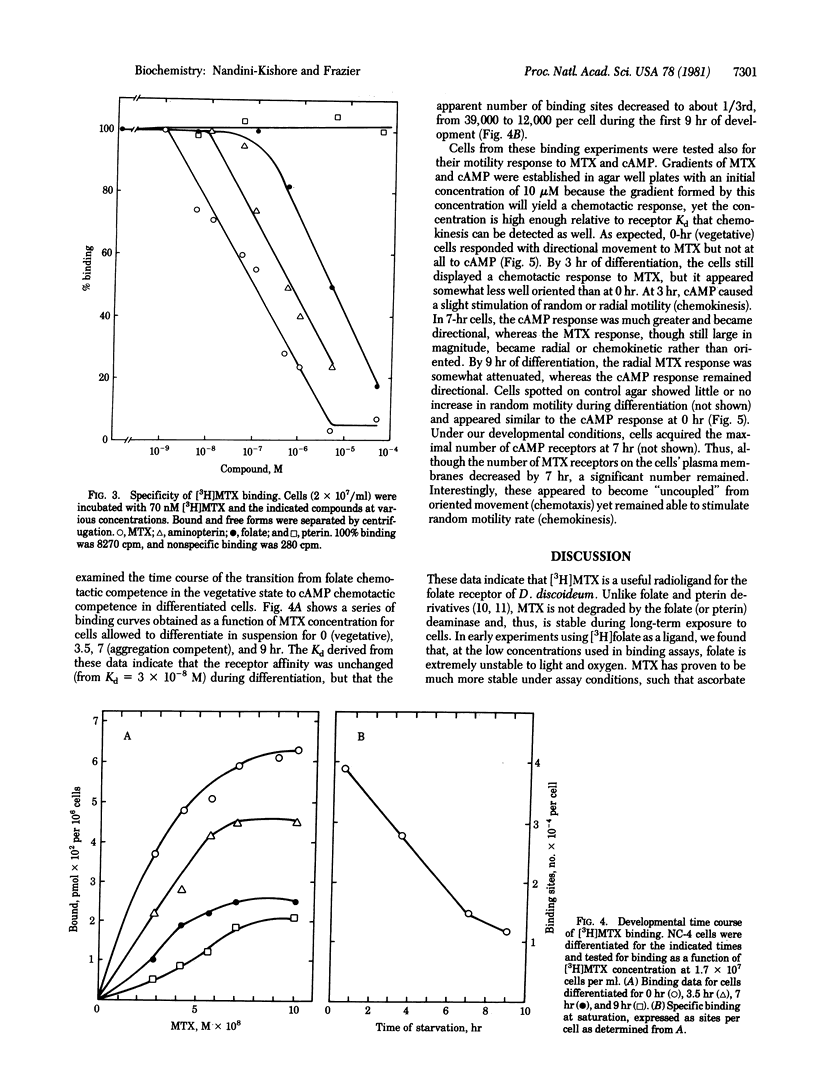Abstract
Studies of the folate chemotactic receptor of vegetative Dictyostelium discoideum cells have been hampered by the presence of the degradative enzyme folate deaminase. The diaminopterin compounds aminopterin and methotrexate (MTX) are chemoattractants but are not attacked by the deaminase. [3',5',7,9-3H]methotrexate ([3H]MTX) is a nondegraded radioligand for the folate receptor. Binding to the receptor is rapid, reaching steady state in less than one min, and reversible in less than 15 s by an excess of unlabeled MTX. A single class of binding sites is found with a Kd of 2 x 10(-8) M, which correlates well with the concentration dependence of chemotaxis. Folate, aminopterin, and MTX all compete for [3H]MTX binding, whereas pterin, p-aminobenzoate, and nucleotides do not. Analysis of the receptor during differentiation indicates a decrease in site number by a factor of 3 with no change in affinity during the first 7 hr. During this time, the directional response (chemotaxis) to MTX and folate is lost, but a nondirectional stimulation of motility rate (chemokinesis) is retained. The response to cyclic AMP displays reciprocal behavior, first appearing as a chemokinetic response and then as a chemotactic response.
Full text
PDF




Selected References
These references are in PubMed. This may not be the complete list of references from this article.
- Kakebeeke P. I., de Wit R. J., Konijn T. M. Folic acid deaminase activity during development in Dictyostelium discoideum. J Bacteriol. 1980 Jul;143(1):307–312. doi: 10.1128/jb.143.1.307-312.1980. [DOI] [PMC free article] [PubMed] [Google Scholar]
- King A. C., Frazier W. A. Properties of the oscillatory cAMP binding component of Dictyostelium discoideum cells and isolated plasma membranes. J Biol Chem. 1979 Aug 10;254(15):7168–7176. [PubMed] [Google Scholar]
- Mato J. M., Van Haastert P. J., Krens F. A., Rhijnsburger E. H., Dobbe F. C., Konijn T. M. Cyclic AMP and folic acid mediated cyclic GMP accumulation in Dictyostelium discoideum. FEBS Lett. 1977 Jul 15;79(2):331–336. doi: 10.1016/0014-5793(77)80814-4. [DOI] [PubMed] [Google Scholar]
- Orlow S. J., Shapiro R. I., Franke J., Kessin R. H. The extracellular cyclic nucleotide phosphodiesterase of Dictyostelium discoideum. Purification and characterization. J Biol Chem. 1981 Jul 25;256(14):7620–7627. [PubMed] [Google Scholar]
- Pan P., Hall E. M., Bonner J. T. Determination of the active portion of the folic acid molecule in cellular slime mold chemotaxis. J Bacteriol. 1975 Apr;122(1):185–191. doi: 10.1128/jb.122.1.185-191.1975. [DOI] [PMC free article] [PubMed] [Google Scholar]
- Pan P., Hall E. M., Bonner J. T. Folic acid as second chemotactic substance in the cellular slime moulds. Nat New Biol. 1972 Jun 7;237(75):181–182. doi: 10.1038/newbio237181a0. [DOI] [PubMed] [Google Scholar]
- Pan P., Wurster B. Inactivation of the chemoattractant folic acid by cellular slime molds and identification of the reaction product. J Bacteriol. 1978 Dec;136(3):955–959. doi: 10.1128/jb.136.3.955-959.1978. [DOI] [PMC free article] [PubMed] [Google Scholar]
- Soll D. R., Waddell D. R. Morphogenesis in the slime mold Dictyostelium discoideum. 1. The accumulation and erasure of "morphogenetic information". Dev Biol. 1975 Dec;47(2):292–302. doi: 10.1016/0012-1606(75)90283-3. [DOI] [PubMed] [Google Scholar]
- Varnum B., Soll D. R. Chemoresponsiveness to cAMP and folic acid during growth, development, and dedifferentiation in Dictyostelium discoideum. Differentiation. 1981;18(3):151–160. doi: 10.1111/j.1432-0436.1981.tb01116.x. [DOI] [PubMed] [Google Scholar]
- Vogel G., Thilo L., Schwarz H., Steinhart R. Mechanism of phagocytosis in Dictyostelium discoideum: phagocytosis is mediated by different recognition sites as disclosed by mutants with altered phagocytotic properties. J Cell Biol. 1980 Aug;86(2):456–465. doi: 10.1083/jcb.86.2.456. [DOI] [PMC free article] [PubMed] [Google Scholar]
- Wallace L. J., Frazier W. A. Photoaffinity labeling of cyclic-AMP- and AMP-binding proteins differentiating Dictyostelium discoideum cells. Proc Natl Acad Sci U S A. 1979 Sep;76(9):4250–4254. doi: 10.1073/pnas.76.9.4250. [DOI] [PMC free article] [PubMed] [Google Scholar]
- Wurster B., Butz U. Reversible binding of the chemoattractant folic acid to cells of Dictyostelium discoideum. Eur J Biochem. 1980 Aug;109(2):613–618. doi: 10.1111/j.1432-1033.1980.tb04834.x. [DOI] [PubMed] [Google Scholar]
- Wurster B., Schubiger K., Brachet P. Cyclic GMP and cyclic AMP changes in response to folic acid pulses during cell development of Dictyostelium discoideum. Cell Differ. 1979 Jun;8(3):235–242. doi: 10.1016/0045-6039(79)90050-2. [DOI] [PubMed] [Google Scholar]
- Wurster B., Schubiger K. Oscillations and cell development in Dictyostelium discoideum stimulated by folic acid pulses. J Cell Sci. 1977;27:105–114. doi: 10.1242/jcs.27.1.105. [DOI] [PubMed] [Google Scholar]
- Wurster B., Schubiger K., Wick U., Gerisch G. Cyclic GMP in Dictyostelium discoideum, Oscillations and pulses in response to folic acid and cyclic AMP signals. FEBS Lett. 1977 Apr 15;76(2):141–144. doi: 10.1016/0014-5793(77)80139-7. [DOI] [PubMed] [Google Scholar]
- Zigmond S. H. Ability of polymorphonuclear leukocytes to orient in gradients of chemotactic factors. J Cell Biol. 1977 Nov;75(2 Pt 1):606–616. doi: 10.1083/jcb.75.2.606. [DOI] [PMC free article] [PubMed] [Google Scholar]


